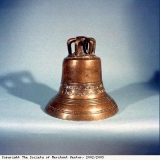Slave traders
The image here shows the Calabar bell, which was given as a gift from the Bristol slave merchant Thomas Jones to Robin John, one of his African trading partners in Old Calabar (in what is now Nigeria, West Africa). It is likely that Jones had met Robin John, and that they were in close correspondence. The supply of enslaved Africans on this part of the coast was controlled by the Efik people of Old Calabar. Gifts were given (and asked for) to keep the goodwill of a trading partner. The inscription on the bell reads ‘The Gift of Thomas Jones of Bristol To Grandy Robin John of Old Town, Old Calabar 1770’. Another gift from a Bristol-based trader has recently been found in Nigeria. It is an ornate brass tea-urn with an inscription showing that it too was given to Robin John of Old Calabar. Robin John was known as ‘Grandy’ Robin John. This title was probably given by his trading partners and meant ‘grandee’ or lord.
Despite such personal links, Bristol ships’ captains, alongside London and Liverpool captains, were involved in attacks on Old Calabar by cannon fire. These bombardments were designed to frighten the traders to force down the price of slaves demanded by the traders there.
Slave traders from Europe and Africa benefitted from their dealings with each other. The Europeans were offered the slaves to buy, which could supply the plantations in the Caribbean with a strong workforce. The African slave traders were supplying a demand set by the Europeans. The African traders received goods in return, which were not otherwise available in Africa. Possession of such goods could increase their status and prestige. Amongst the trade goods were guns. Ownership of guns meant that the African traders could overwhelm (and often enslave) people in their area. Warfare was easier with the guns they bought from the Europeans, as long as their enemies did not have guns and could not protect themselves.



